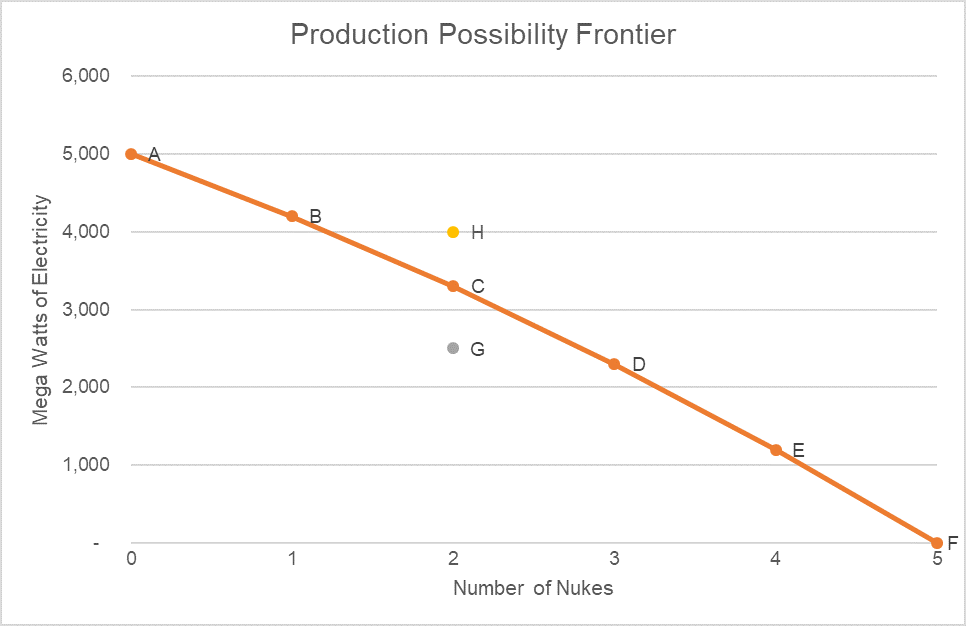Production Possibility Frontier
Production possibility frontier (also called production possibility curve) is a plot that shows the maximum outputs that an economy can produce from the available inputs (i.e. factors of production).
Since resources are scarce, deciding about what to produce is of pivotal importance for individuals, firms, governments and whole economies. Production possibility frontier is a good tool that helps decision-makers imagine their production choices and tradeoffs and determine whether they are producing at their full potential.
Let’s consider a country which can produce either 5 nukes or 5,000 megawatts of electricity using the available factors of production i.e. land, labor and capital. The following table shows the different ‘production possibilities’ that correspond to the available resources of uranium, trained metallurgists and scientists and capital:
| Option | Number of Nukes | Electricity (Megawatts) |
|---|---|---|
| A | 0 | 5,000 |
| B | 1 | 4,200 |
| C | 2 | 3,300 |
| D | 3 | 2,300 |
| E | 4 | 1,200 |
| F | 5 | - |
A plot of the above data is the production possibility frontier.

It shows that country can either produce 5 nukes per year using the available technical knowledge or 5,000 megawatts of electricity or a combination but for each additional nuke, 1,000 megawatts of electricity must be sacrificed i.e. producing nukes have opportunity costs. The choices made today have serious implications for future i.e. if more resources are assigned to production of nukes, the country would have serious energy short-fall will dampen growth and shrink the country’s overall production possibilities.
Infeasible and Inefficient Production
If an economy’s total production falls within the production possibility frontier, i.e. as in Point G in the PPF plotted above, it is producing at below their potential. It is referred to as inefficient production. It is because at Point G, the country is producing 2 nukes and 2,500 megawatts of electricity while it has the potential to produce 2 nukes and 3,300 megawatts of electricity. Many countries produce at a point inside their production possibility fronteir due to business cycles because the market system is not able to correctly match the supply and demand.
Similarly, an economy can’t produce a combination of products outside their production possibility frontier. Point H in the chart above is an infeasible production goal because it falls outside the PPF. The country can’t produce 2 nukes and 4,000 megawatts of electricity at the same time. However, by investing in new technology and thereby improving productivity, a country can shift its production possibility outwards and achieve the production goal in future.
Factors that Shift Production Possibility Frontier
As we move along the production possibility frontier i.e. from A to B or B to C and so on, the total production remains constant and we are just substituting one product for another. This happens when the available inputs and technology is the same. However, there are certain factors that increases or decrease an economy’s total production potential and they cause and inward or outward shift in the PPF.
Inward shifts in production possibility frontier means that the economy is shrinking i.e. its production potential is decreases. Factors that can lead to this include:
- Natural disasters such as earth quakes, floods, etc. can have devastating effects on a country. It reduces the production potential by decreasing the quantity of land, destroying infrastructure i.e. capital and decreasing population i.e. labor.
- Wars, terrorism, violent protests and other political disruptions can stall the economic activity and shift the PPF inwards.
- Outward immigration i.e. brain drain causes the skilled people to immigrate to other countries which reduces over production potential.
- Spending too much on current consumption or unproductive pursuits (for example, engaging in an arms race) decreases the creation of new capital which can cause PPF inwards shifts in future.
Outwards shifts in PPF causes an increase in an economy’s production potential. Factors that result in outwards shifts include:
- New inventions i.e. improvement in technology: it increases productivity of other factors of production. This happens when societies forego current consumption to save and invest in capital goods such as roads, etc.
- Population growth and inward immigration: it leads to an increase in the stock of skilled labor.
- Investment in education and other training opportunities: it increases the human capital of a society.
by Obaidullah Jan, ACA, CFA and last modified on